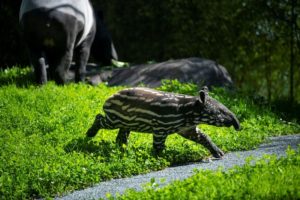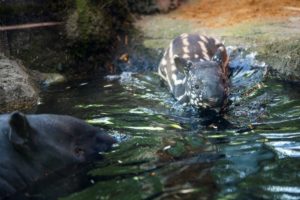
UPDATE: Kazu made his public debut Aug. 30. He and Yuna are now viewable in the Asian Forest Sanctuary late morning-early afternoon on weekends.
Trotting over green grass. Figuring out stairs. Swimming. A brand-new, exciting world for Kazu the tapir calf is in store this weekend at Point Defiance Zoo & Aquarium, as the seven-week-old will explore the Asian Forest Sanctuary for the first time.
Brown with white stripes and spots, the baby tapir still looks like a tubby watermelon on legs. But those legs are getting stronger.
“Kazu is fearless!” said Telena Welsh, senior staff biologist at the Asian Forest Sanctuary. “He will definitely be curious about this new adventure.”
Born on July 12, Kazu spent the first seven weeks of his life behind the scenes while he nursed, bonded with his mom Yuna, and grew.
His name means “first” in Japanese. It’s a good fit: the calf is the first tapir born in the zoo’s 114-year history, and Yuna and Baku, his parents’ names, are also Japanese.
The name was chosen this week by public vote from a slate of five offered by keepers in the Asian Forest Sanctuary. In total, 12,709 votes were received – a record for the zoo, which has also seen a beaver kit, tamandua pup and eight red wolf pups born this season.
Now 80 pounds and adding more every day, the tapir calf trots eagerly beside his mom, wiggling his long nose to smell exciting new scents and foods. He’ll nurse until he’s 4-6 months old, but is gradually adding adult foods like banana, pears, yams, romaine and grains to his diet.
But maybe the newest part of Kazu’s new outdoor world will be the pool.
 Tapirs are good swimmers, even using their long nose as a snorkel, and each of the five habitats in the Asian Forest Sanctuary has a water feature. So for the last few weeks, Kazu has been practicing in a small pool indoors. When he makes his debut, he’ll learn to swim in the big pool alongside Yuna.
Tapirs are good swimmers, even using their long nose as a snorkel, and each of the five habitats in the Asian Forest Sanctuary has a water feature. So for the last few weeks, Kazu has been practicing in a small pool indoors. When he makes his debut, he’ll learn to swim in the big pool alongside Yuna.
“We will watch them closely over the next few weeks as they get used to their new habitat, and the calf continues to practice his swimming,” says Welsh.
Kazu and Yuna will be viewable by the public Friday through Monday on Labor Day Weekend. (Times may vary through the day depending on mom and baby’s needs, and they may not be visible all day.)
Although they look a lot like pigs with elephantine trunks, tapirs are actually related to horses and rhinoceroses. Native to jungles of Southeast Asia, adults are gray and black to camouflage their shape in the forest, while their calves’ watermelon-like spots hide and protect them in dappled shade.
Malayan tapirs once were found throughout the lowland rainforests of Southeast Asia. But the species’ numbers have declined dramatically due to human-animal conflict, including deforestation of their natural habitat, and they are now endangered. Only around 2,500 remain scattered in Thailand, peninsular Malaysia and the Indonesian island of Sumatra.
Kazu represents hope for the species: His birth came as the result of a breeding recommendation for Yuna and father Baku by the Association of Zoos & Aquariums’ Species Survival Plan® for Malayan tapirs. The Species Survival Plan team looks at the genetic makeup of each prospective parent before recommending a pairing; this helps ensure diversity of the small Malayan tapir population in North American zoos.
For more information, go to www.pdza.org/tapir-calf